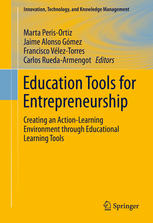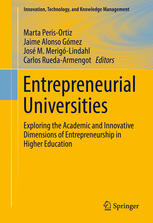Entrepreneurship Education at Universities Learning from Twenty European Cases 1st Edition by Christine Volkmann,David Audretsch 3319555464 9783319555461
$50.00 Original price was: $50.00.$25.00Current price is: $25.00.
Entrepreneurship Education at Universities Learning from Twenty European Cases 1st Edition by Christine Volkmann,David Audretsch – Ebook PDF Instant Download/Delivery:3319555464,9783319555461
Full download Entrepreneurship Education at Universities Learning from Twenty European Cases 1st Edition after payment

Product details:
ISBN 10:3319555464
ISBN 13:9783319555461
Author:Christine Volkmann,David Audretsch
This volume discusses entrepreneurship education in Europe on the basis of in-depth case studies of related activities at twenty higher education institutions. Based on a model of entrepreneurship education, the analysis addresses curricular and extra-curricular teaching, as well as the institutional and stakeholder context of delivering entrepreneurship education within higher educational institutions. The book offers both insightful entrepreneurship teaching practices and a discussion of potential organizational drivers and barriers. Accordingly, it provides a valuable resource for researchers, instructors, and managers of entrepreneurship education alike.
Entrepreneurship Education at Universities Learning from Twenty European Cases 1st Table of contents:
Part I: Entrepreneurship Education in Northern Europe
Lund University: Embedding Entrepreneurship in a Regional Context
1 The University´s Entrepreneurship Education Profile
1.1 The University´s Overall Approach to Entrepreneurship Education
1.2 Leadership and Governance
Importance of Government Strategies
Importance of Entrepreneurship in the University´s Strategy
Extent of High Level Commitment to Implementing Entrepreneurship
Level of Faculties´ and Units´ Autonomy to Act
Organisational Implementation
1.3 Resources: People and Financial Capacity
Human Resources for Entrepreneurship Education
Financial Resources for Entrepreneurship Education
2 Entrepreneurship in Curricula and Teaching
2.1 Overview of Curricular Offers
2.2 Target Groups
Main Target Groups of Entrepreneurship Education
Continuous Education
Bridges to Secondary Education
Specificities
2.3 Designing Lectures and Courses: Basic Curricular Decisions
Intentions and Objectives
Contents
Methods and Media
Informal Evaluation of Learning Outcomes and Feedback for Students
Using Results of Entrepreneurship Research
2.4 Setting of Entrepreneurship Teaching
Locations
Timing
Formal Evaluation of Learning Outcomes
2.5 Instructors: Teachers and Mentors
Professors, Other Employees and External Lecturers of the University
“Real Entrepreneurs´´ as Teachers
Mentors
2.6 Management of Entrepreneurship Education
Teacher and Trainer Management
Internal and External Network Management
Evaluation of Courses and Programmes
3 Extra-Curricular Activities Related to Entrepreneurship Education
3.1 Overview of Extra-Curricular Entrepreneurship Activities
Box 1 Venture Cup
Box 2 Dragons at the University
Box 3 Leapfrogs
Box 4 FENA
Box 5 European EE Workshop and European Entrepreneurship Award
4 Institutional Aspects of Entrepreneurship Education
4.1 Organisational Set-up and Change
4.2 Laws, Statutes and Codes
4.3 Mindsets and Attitudes
5 External Relationships Related to Entrepreneurship Education
5.1 Types of Relationships with External Stakeholders
5.2 External Stakeholders Involved in Entrepreneurship Education
Enterprises
Alumni
Student Organisations
Support Services
Incubators
Incubator: Venture Lab
Incubator: Ideon Innovation
Incubator: The Creative Plot (TCP)
Science and Technology Parks
5.3 International Relationships
6 Impact and Lessons Learned
6.1 Evaluating Impacts of the Entrepreneurship Education Approach
Impact and Transferability of Entrepreneurship Education to Other Universities
6.2 Lessons Learned
Summary of Lessons Learned from This Case
References
Interviews
Websites and Publications
University of Southern Denmark: IDEA Centre for Promoting Entrepreneurship Education Across the Univ
1 The University´s Entrepreneurial Profile
1.1 The University´s Overall Approach to Entrepreneurship
1.2 Leadership and Governance
Importance of Government Strategies
Importance of Entrepreneurship in the University´s Strategy
Extent of High Level Commitment to Implementing Entrepreneurship
Level of Faculties´ and Units´ Autonomy to Act
University´s Importance for Driving Entrepreneurship in Its Environment
1.3 Resources: People and Financial Capacity
Human Resources for Entrepreneurship Education
Financial Resources for Entrepreneurship Education
2 Entrepreneurship in Curricula and Teaching
2.1 Overview About Curricular Offers in Entrepreneurship Education
2.2 Target Groups
Main Target Groups of Entrepreneurship Education
Continuous Education
Bridges to Secondary Education
Specificities
2.3 Designing Lectures and Courses: Basic Curricular Decisions
Intentions
Contents
Box 1 Design Entrepreneurship
Methods
Media
Informal Evaluation of Learning Outcomes and Feedback for Students
Using Results of Entrepreneurship Research
2.4 Setting of Entrepreneurship Teaching
Locations
Timing
Formal Evaluation of Learning Outcomes
2.5 Instructors: Teachers and Mentors
Professors, Other Employees and External Lecturers of the University
“Real Entrepreneurs´´ as Teachers
Mentors
2.6 Management of Entrepreneurship Education
Teacher and Trainer Management
Managing Student Support
Internal and External Network Management
Management of Curricular Integration and Attracting New Groups of Students
Evaluation of Courses and Programmes
3 Extra-Curricular Activities in Entrepreneurship Education
4 Institutional Aspects of Entrepreneurship Education
4.1 Organisational Set-up and Change
Measures for Coordinating and Integrating EE Across the University
4.2 Laws, Statutes and Codes
Incentives for Staff to Engage in or Support Entrepreneurship Education
Incentives for Other Stakeholders Contributing to Entrepreneurship Education
4.3 Mindsets and Attitudes
Raising Awareness for the Importance of Entrepreneurship
Encouraging Entrepreneurial Behaviour
5 Outreach to External Stakeholders for Entrepreneurship Education
5.1 Types of Relationships with External Stakeholders
5.2 External Stakeholders Involved in Entrepreneurship Education
Incubators, Accelerators, Science Parks and Technology Parks
5.3 International Relationships
6 Impact and Lessons Learned
6.1 Evaluating Impacts of the Entrepreneurship Education Approach
Overview of Impact Evaluation Methods Applied
Students´ Participation Rates in EE Courses
Entrepreneurial Self-Efficacy of SDU Students
6.2 Lessons Learned
Summary of Lessons Learned from this Case
Transferability to Other Universities
References
Interviews
Literature and Websites
Tampere University of Applied Sciences: Team Learning and Team Entrepreneurship
1 The University´s Entrepreneurial Profile
1.1 The University´s Overall Approach to Entrepreneurship Education
Key Characteristics of EE at TAMK
Publicity of the TAMK Case
1.2 Leadership and Governance
Importance of Government Strategies
Importance of Entrepreneurship in the University´s Strategy
Extent of High Level Commitment to Implementing Entrepreneurship
Level of Faculties´ and Units´ Autonomy to Act
Organizational Implementation
University´s Importance for Driving Entrepreneurship in Its Environment
1.3 Resources: People and Financial Capacity
Human Resources for Entrepreneurship Education
Financial Resources for Entrepreneurship Education
2 Entrepreneurship in Curricula and Teaching
2.1 Overview About Curricular Offers
Curricular Offers by Proacademy
Proacademy Degree Programme in Business Administration
Curricular Offers by Y-kampus
2.2 Target Groups
Target Groups of Proacademy
Study Programmes and Students´ Backgrounds
Special Target Group: Potential Family Business Successors
Selecting the Right Candidates
Target Groups of Y-kampus
Continuous Education
Bridges to Secondary Education
2.3 Designing Lectures and Courses: Basic Curricular Decisions
Objectives
Contents and Methods
Applying the TeamAcademy Concept
Working in Real Companies
Specific Methods and Media Used
Informal Evaluation of Learning Outcomes and Feedback for Students
Formal Evaluation of Learning Outcomes
2.4 Setting of Entrepreneurship Teaching
Locations
Timing
2.5 Instructors: Teachers and Mentors
Professors, Other Employees and External Lecturers of the University
“Real Entrepreneurs´´ as Teachers
Mentors
2.6 Management of Entrepreneurship Education
Teacher and Trainer Management
Managing Student Support
Internal and External Network Management
Management of Curricular Integration and Attracting New Groups of Students
Evaluation of Courses and Programmes
3 Extra-curricular Activities Related to Entrepreneurship Education
4 Institutional Aspects of Entrepreneurship Education
4.1 Organizational Set-up and Change
4.2 Laws, Statutes and Codes
4.3 Mindsets and Attitudes
Raising Awareness for the Importance of Entrepreneurship
Encouraging Entrepreneurial Behaviour
5 Outreach to External Stakeholders
5.1 Types of Relationships with External Stakeholders
5.2 External Stakeholders Involved in Entrepreneurship Education
Enterprises
Financial Institutions
Support Services
Incubators, Accelerators, Science Parks and Technology Parks
5.3 International Relationships
6 Impact and Lessons Learned
6.1 Evaluating Impacts of the Entrepreneurship Education Approach
Overview of Impact Evaluation Methods Applied
Impact Evaluation Methods and Findings
Number of Start-ups
6.2 Lessons Learned
Summary of Lessons Learned About Methods and Settings
Preconditions for Establishing a Radically Different Type of EE
Mainstreaming EE Across the University
Marketing to New Types of Students and Stakeholders
Improving the Regional Business Environment
Transferability to Other Universities
References
Interviews
Literature and Websites
Part II: Entrepreneurship Education in Central-Eastern Europe
Kaunas University of Technology: Developing Entrepreneurship Education with International Expert Net
1 The University´s Entrepreneurial Profile
1.1 The University´s Overall Approach to Entrepreneurship Education
1.2 Leadership and Governance
Importance of Governmental Activities for Developing EE
Importance of Entrepreneurship in the University´s Strategy
Extent of Top Management Commitment to Implementing Entrepreneurship
Level of Schools´ and Departments´ Autonomy to Act
Organizational Implementation
University´s Importance for Driving Entrepreneurship in its Environment
1.3 Resources: People and Financial Capacity
Human Resources for Entrepreneurship Education
Financial Resources for Entrepreneurship Education
2 Entrepreneurship in Curricula and Teaching
2.1 Overview About Curricular Offers
Box 1 Technology Entrepreneurship (KTU 2015)
Box 2 Technology Venturing (KTU 2015)
2.2 Target Groups
Main Target Groups of Entrepreneurship Education
Continuous Education
Bridges to Secondary Education
2.3 Designing Lectures and Courses: Basic Curricular Decisions
Objectives
Contents
Methods
Technology Entrepreneurship
Technology Venturing
Media
Informal Evaluation of Learning Outcomes and Feedback for Students
Formal Evaluation of Learning Outcomes
2.4 Setting of Entrepreneurship Teaching
Locations
Timing
2.5 Instructors: Teachers and Mentors
Professors, Other Employees and External Lecturers of the University
“Real Entrepreneurs´´ as Teachers
Mentors
2.6 Management of Entrepreneurship Education
Management of EE Teachers
Managing Student Support
Internal and External Network Management
Management of Curricular Integration and Attracting Students
Evaluation of Courses
Managing Entrepreneurship Education Finance
3 Extra-Curricular Activities Related to Entrepreneurship Education
Box 3 Start-up Sauna
4 Institutional Aspects of Entrepreneurship Education
4.1 Organizational Set-up and Change
Co-ordinating and Integrating Entrepreneurship Education Across the University
Influence of External Stakeholders in the Entrepreneurship Education Programmes
4.2 Laws, Statutes and Codes
Incentives for Staff to Engage in or Support Entrepreneurship Education
Incentives for Other Stakeholders Contributing to Entrepreneurship Education
4.3 Mindsets and Attitudes
Raising Awareness for the Importance of Entrepreneurship
Encouraging Entrepreneurial Behaviour
5 Outreach Activities Related to Entrepreneurship Education
5.1 Building an International Network of Advisors and Peers
Three Key Organizations Consulting KTU
How KTU´s Network Developed
Limitations of Involving Advisors from Other Countries
Peer-to-Peer Consultation
5.2 Further External Stakeholders
Enterprises
Incubators, Accelerators, Science Parks and Technology Parks
6 Impact and Lessons Learned
6.1 Evaluating Impacts of Entrepreneurship Education
Evaluating Students´ Learning Progress
Numbers and Examples of Start-ups from KTU
Outlook to Possible Future Impacts of Entrepreneurship Education at KTU
6.2 Lessons Learned
Summary of Lessons Learned from this Case
Transferability to Other Universities
References
Interviews
Participations
Literature and Websites
Technical University of Kosice: Extra-curricular Entrepreneurship Education Activities and Start-up
1 The University´s Entrepreneurial Profile
1.1 The University´s Overall Approach to Entrepreneurship Education
1.2 Leadership and Governance
Importance of Government Strategies
Importance of Entrepreneurship in the University´s Strategy
Organisational Implementation
1.3 Resources: People and Financial Capacity
Human Resources for Entrepreneurship Education
2 Entrepreneurship in Curricula and Teaching
2.1 Overview About Curricular Offers
2.2 Target Groups
2.3 Designing Lectures and Courses: Basic Curricular Decisions
Intentions
Contents
Methods
Informal Evaluation of Learning Outcomes and Feedback for Students
2.4 Setting of Entrepreneurship Teaching
Timing
Formal Evaluation of Learning Outcomes
2.5 Instructors: Teachers and Mentors
Professors, Other Employees and External Lecturers of the University
“Real Entrepreneurs´´ as Teachers
3 Extra-curricular Activities Related to Entrepreneurship Education
3.1 Overview About Extra-curricular Entrepreneurship Activities
3.2 Target Groups of Extra-curricular Activities
3.3 Designing Extra-curricular Activities
Intentions
Contents
Informal Assessment of Learning Outcomes and Feedback for Students
3.4 Setting of Extra-curricular Activities
Locations
Timing
3.5 Persons Involved in Extra-curricular Activities
3.6 Management of Extra-curricular Activities
Managing Student Support
Internal and External Network Management
4 Institutional Aspects of Entrepreneurship Education
4.1 Organisational Set-up and Change
Measures for Coordinating and Integrating EE Across the University
Managing the Acquisition of Resources
4.2 Laws, Statutes and Codes
4.3 Mindsets and Attitudes
Raising Awareness for the Importance of Entrepreneurship
Encouraging Entrepreneurial Behaviour
5 External Relationships Related to Entrepreneurship Education
5.1 Types of Relationships with External Stakeholders
5.2 External Stakeholders Involved in Entrepreneurship Education
Role of External Stakeholders in Entrepreneurship Teaching Activities
Influence of External Stakeholders in the Entrepreneurship Education
6 Impact and Lessons Learned
6.1 Evaluating Impacts of the Entrepreneurship Education Approach
6.2 Lessons Learned
Summary of Lessons Learned from This Case
Transferability to Other Universities
References
Interviews
Literature and Websites
Kozminski University: Developing Minds for Ambitious Entrepreneurship and Training Teachers at Other
1 The University´s Entrepreneurial Profile
1.1 The University´s Overall Approach to Entrepreneurship Education
Key Characteristics of EE at Kozminski University
Publicity of the Kozminski Case
1.2 Leadership and Governance
Importance of Government Strategies
Importance of EE in the University´s Strategy
Extent of High Level Commitment to Implementing Entrepreneurship Education
Level of Faculties´ and Units´ Autonomy to Act and Organisational Implementation
1.3 Resources: People and Financial Capacity
Human Resources for Entrepreneurship Education
Financial Resources for Entrepreneurship Education
2 Entrepreneurship in Curricula and Teaching
2.1 Overview About Curricular Offers
2.2 Origins and Operationalisation of Teaching Ambitious Entrepreneurship at KU
External and Internal Environment
External Factors
Internal Factors
Learning from International Experiences
2.3 Target Groups
2.4 Designing Lectures and Courses: Basic Curricular Decisions
Objectives of EE: Operationalisation of Ambitious Entrepreneurship for Teaching
Pilot Programme Development
Teaching Methods
2.5 Setting of Entrepreneurship Teaching
Locations of EE Offers
Timing of EE Offers
2.6 Instructors: Teachers and Mentors
EE Teachers from KU
Guest Speakers
2.7 Management of Entrepreneurship Education
Teacher and Trainer Management at KU
Extending Ambitious Entrepreneurship Education to Other Universities
3 Extra-Curricular Projects in Entrepreneurship Education
3.1 Overview About Extra-Curricular EE Activities at Kozminski University
3.2 How to Start Your Own Business
3.3 Warsaw, the Capital of Ambitious Business (2009-2011)
3.4 Entrepreneurship in Creative Industries (2009-2013)
3.5 INNOVATOR (2007-2009)
3.6 Aula Polska (2012 Onwards)
3.7 Overall Initial Results
4 Institutional Aspects of Entrepreneurship Education
4.1 Organisational Set-up and Change
4.2 Mindsets and Attitudes
5 Outreach to External Stakeholders
5.1 Relationships with Business Community
5.2 Training Educators from Other Polish Universities
Lessons from International Experiences
Situation in Teaching Entrepreneurship in Polish Non-Business Universities
“Training of Trainers´´ Projects Initiated by KU During 2007-2011
Entrepreneurship Lecturers Participating in the Programme
Box 1 An Exemplary Case of Shaping Lecturers´ Entrepreneurial Mindsets
Support from the Leadership of Participating Universities
Network of Academic Entrepreneurship Educators in Poland (SEIPA)
6 Impact and Lessons Learned
6.1 Measuring Impacts of KU´s Entrepreneurship Education Approach
6.2 Lessons Learned: Success Factors for Launching EE
Summary of Lessons Learned from This Case
Transferability to Other Universities
References
Literature
Part III: Entrepreneurship Education in South-Eastern Europe
Bucharest University of Economic Studies: Developing a Strong and Distinct Position for Providing En
1 The University´s Entrepreneurial Profile
1.1 The University´s Overall Approach to Entrepreneurship Education
1.2 Leadership and Governance
Importance of Government Strategies
Importance of Entrepreneurship in the University´s Strategy
Extent of High Level Commitment to Implementing Entrepreneurship
Level of Faculties´ and Units´ Autonomy to Act
University´s Importance for Driving Entrepreneurship in Its Environment
1.3 Resources: People and Financial Capacity
Human Resources for Entrepreneurship Education
Financial Resources for Entrepreneurship Education
2 Entrepreneurship in Curricula and Teaching
2.1 Overview of Curricular Offers
Box 1 Entrepreneurial Management
Box 2 Entrepreneurship and Business Administration in the Energy Sector
Box 3 Entrepreneurship Culture Course
2.2 Target Groups
Main Target Groups of Entrepreneurship Education
Specificities
2.3 Designing Lectures and Courses: Basic Curricular Decisions
Contents
Methods
2.4 Instructors: Teachers and Mentors
Professors, Other Employees and External Lecturers of the University
2.5 Management of Entrepreneurship Education
Teacher and Trainer Management
Internal and External Network Management
Evaluation of Courses
3 Extra-curricular Activities Related to Entrepreneurship Education
3.1 Overview About Extra-curricular Entrepreneurship Activities
Box 4 Junior Achievement Programme
4 Institutional Aspects of Entrepreneurship Education
4.1 Organisational Set-up and Change
Measures for Coordinating and Integrating Entrepreneurship Education Across the University
Influence of External Stakeholders in the Entrepreneurship Education Programmes
4.2 Laws, Statutes and Codes
Incentives for Staff to Engage in or Support Entrepreneurship Education
4.3 Mindsets and Attitudes
Raising Awareness for the Importance of Entrepreneurship
Encouraging Entrepreneurial Behaviour
5 External Relationships Related to Entrepreneurship Education
5.1 External Stakeholders Involved in Entrepreneurship Education
Enterprises
Other Stakeholders
5.2 International Relationships
6 Lessons Learned
References
Interviews
Literature and Websites
University of Ljubljana: Applying the Design-Thinking Approach to Entrepreneurship Education
1 The University´s Entrepreneurship Education Profile
1.1 The University´s Overall Approach to EE
Key Characteristics of EE at the University of Ljubljana
Publicity of the Case
1.2 Leadership and Governance
Extent of High Level Commitment to Implementing Entrepreneurship
Importance of Entrepreneurship in the University´s Strategy
Level of Autonomy to Introduce EE Courses
1.3 Resources: People and Financial Capacity
Human Resources for Entrepreneurship Education
Financial Resources for Entrepreneurship Education
2 Entrepreneurship in Curricula and Teaching
2.1 Overview About Curricular Offers
2.2 Target Groups
Main Target Groups of Entrepreneurship Education at FELU
Bridges to School Education
Continuous Education: DT Course for Unemployed People
2.3 Designing Lectures and Courses: Basic Curricular Decisions
Objectives
“Entrepreneurship´´: Undergraduate
“Development of Entrepreneurial Opportunities´´: Undergraduate
“Entrepreneurial Project 1´´: Undergraduate
“Entrepreneurial Project 2´´: Graduate
“Effective Presentations´´
2.4 Setting of Entrepreneurship Teaching
2.5 Instructors: Teachers and Mentors
Professors, Other Employees and External Lecturers of the University
“Real Entrepreneurs´´ as Teachers
2.6 Management of Entrepreneurship Education
3 Extra-Curricular Activities in Entrepreneurship Education
3.1 Overview About Extra-Curricular Entrepreneurship Activities
3.2 Start-up Weekends
3.3 Consulting
3.4 Workshops and Lectures
4 Institutional Aspects of Entrepreneurship Education
4.1 Organisational Set-up and Change
Application of DT in Other Faculties
Barriers to Multi-disciplinarity
4.2 Laws, Statutes and Codes
Legal Barriers for Students to Act Entrepreneurially
4.3 Mindsets and Attitudes
Socio-cultural Issues Hampering Entrepreneurial Mindsets
5 Outreach to External Stakeholders of Entrepreneurship Education
6 Impact and Lessons Learned
6.1 Measuring Impacts of Entrepreneurship Education
Impact Evaluation Methods Applied
Start-ups Evolving from DT at the University of Ljubljana
6.2 Lessons Learned
Summary of Lessons Learned from This Case
Limitations and Challenges of the DT Approach
Transferability to Other Universities
References
Interviews
Literature and Websites
University of Osijek: Developing Entrepreneurship Education from Scratch over Time
1 The University´s Entrepreneurship Education Profile
1.1 The University´s Overall Approach to Entrepreneurship
1.2 Leadership and Governance
Leadership of Prof. Singer
Historical Barriers to Entrepreneurship Education
Importance of Entrepreneurship in the University´s Strategy and Extent of High-Level Commitment
Organisational Implementation and Level of Autonomy to Act
1.3 Resources: People and Financial Capacity
2 Entrepreneurship in Curricula and Teaching
2.1 Overview About Curricular Offers
Offers for the Full Range of Degrees
Chronological Development of EE at SUO
2.2 Target Groups
Overview About Target Groups
Graduate Programme in Entrepreneurship: Pre-Bologna (Master of Science Degree)
Undergraduate Programme in Entrepreneurship: After Bologna (Bachelor Degree)
Graduate Programme in Entrepreneurship: After Bologna (Master Degree)
Postgraduate Specialist Studies in Entrepreneurship: After Bologna (Specialist Degree)
PhD Programme “Entrepreneurship and Innovation´´
2.3 Designing Lectures and Courses: Basic Curricular Decisions
Teaching Objectives
Teaching Methods
2.4 Instructors: Teachers and Mentors
Involving International Experts
Real Entrepreneurs and Guest Speakers as Teachers
Mentors
2.5 Management of Entrepreneurial Education
Internally Growing Competent Staff
3 Extra-Curricular Activities Related to Entrepreneurship Education
3.1 Overview About Extra-Curricular Activities
3.2 Community Work (Volunteering Programme of Graduate Programme in Entrepreneurship)
3.3 Entrepreneurs Without Borders (EWoB)
3.4 Consulting
3.5 Business Plan Competition
4 Institutional Aspects of Entrepreneurship Education
4.1 Organizational Set-up and Change of Entrepreneurship Education
Planned Organizational Changes to Make EE Available to All Students
Shifting EE Leadership
4.2 Legal Barriers to Entrepreneurship Education
4.3 Developing Entrepreneurial Mindsets
5 Outreach to External Stakeholders of Entrepreneurship Education
5.1 Initiating Institutions for an Entrepreneurial Ecosystem on One´s Own
5.2 Finance for Local Enterprises: NOA
5.3 Entrepreneurship Training: Centre for Entrepreneurship
5.4 Policy Think Tank CEPOR
5.5 Business Incubator BIOS
5.6 Regional Centre for Promoting Entrepreneurship
5.7 Involvement of External Stakeholders in University Boards
6 Impact and Lessons Learned
6.1 Measuring Impacts of the Entrepreneurship Education Approach
Overview About Impact Measurement Methods Applied
Findings from the Global Entrepreneurship Monitor
Qualitative Substantiation of the Impact of SUO´s EE Programmes
6.2 Lessons Learned
References
Interviews
Literature and Websites
Part IV: Entrepreneurship Education in South-Western Europe
University of Coimbra: Supporting Nascent Entrepreneurs by Extra-curricular Activities
1 The University´s Entrepreneurial Profile
1.1 The University´s Overall Approach to Entrepreneurship Education
1.2 Leadership and Governance
Importance of Government Strategies
Importance of Entrepreneurship in the University´s Strategy
Extent of High Level Commitment to Implementing Entrepreneurship
Level of Faculties´ and Units´ Autonomy to Act
Organizational Implementation
University´s Importance for Driving Entrepreneurship in Its Environment
1.3 Resources: People and Financial Capacity
Human Resources for Entrepreneurship Education
Financial Resources for Entrepreneurship Education
2 Entrepreneurship in Curricula and Teaching
2.1 Overview of Curricular Offers
2.2 Target Groups
2.3 Designing Lectures and Courses: Basic Curricular Decisions
Box 1 Social Intervention, Innovation and Entrepreneurship Master Programme
Box 2 Innovation and Management Processes Course
Box 3 Entrepreneurial New Ideas Course
Box 4 Technological Innovation and Entrepreneurship Course
Box 5 Entrepreneurship and Business Challenge Course
2.4 Setting of Curricular Activities
Locations and Timing
Formal Evaluation of Learning Outcomes
2.5 Instructors, Teachers and Mentors
2.6 Management of Entrepreneurship Education
Teacher and Trainer Management and Evaluation of Courses and Programmes
Internal and External Network Management
Management of Curricular Integration and Attracting New Groups of Students
3 Extra-curricular Activities Related to Entrepreneurship Education
3.1 Overview About Extra-curricular Entrepreneurship Activities
3.2 Target Groups of Extra-curricular Activities
Bridges to Secondary Education
3.3 Designing Extra-curricular Activities
Box 6 Technology-Based Entrepreneurship Course: Mentoring Programme (CEBT-MT)
Box 7 Cre@tive C
3.4 Setting of Extra-curricular Activities
Locations
Timing
Formal Evaluation of Learning Outcomes
3.5 Persons Involved in Extra-curricular Activities
Evaluation of Extra-curricular Offers
4 Institutional Aspects of Entrepreneurship Education
4.1 Organizational Set-up and Change
4.2 Laws, Statues and Codes
4.3 Mindsets and Attitudes
5 External Relationships Related to Entrepreneurship Education
5.1 Types of Relationships with External Stakeholders
5.2 External Stakeholders Involved in Entrepreneurship Education
Enterprises
Incubators, Accelerators, Science Parks and Technology Parks
5.3 International Relationships
6 Impact and Lessons Learned
6.1 Evaluating Impacts of the Entrepreneurship Education Approach
Overview of Impact Evaluation Methods Applied
6.2 Lessons Learned
Summary of Lessons Learned from This Case
Perspectives for the Future
Transferability to Other Universities
References
Interviews
Literature and Websites
EMLYON: Educating Entrepreneurs as a Prime Objective of a Private Business School
1 The University´s Entrepreneurship Education Profile
1.1 The University´s Overall Approach to Entrepreneurship Education
EMLYON´s Overall Profile
EMLYON´s Overall Approach to Entrepreneurship Education
1.2 Leadership and Governance
Importance of Government Strategies
Importance of Entrepreneurship in the University´s Strategy
Extent of High Level Commitment to Implementing Entrepreneurship
Level of Faculties´ and Units´ Autonomy to Act
Organizational Implementation
University´s Importance for Driving Entrepreneurship in Its Environment
1.3 Resources: People and Financial Capacity
Human Resources for Entrepreneurship Education
Financial Resources for Entrepreneurship Education
2 Entrepreneurship in Curricula and Teaching
2.1 Overview About Curricular Offers
EE Covering All Degree Programmes
Bachelor-Level Programme
Graduate Programmes
Specialized Master Programmes
MBA Programmes
PhD Level Programme
Executive Programmes
Programmes for Entrepreneurs
2.2 Target Groups
Main Target Groups of Entrepreneurship Education
Continuous Education
Bridges to Secondary Education
2.3 Designing Lectures and Courses: Basic Curricular Decisions
Objectives of Entrepreneurship Teaching
EMLYON´s Pedagogical Approach
Methods and Media
Evaluation of Learning Outcomes and Feedback for Students
2.4 Setting of Entrepreneurship Teaching
Locations and Timing
Formal Evaluation of Learning Outcomes
2.5 Instructors: Teachers and Mentors
Professors, Other Employees and External Lecturers of the University
“Real Entrepreneurs´´ as Teachers
2.6 Management of Entrepreneurship Education
3 Extra-Curricular Activities Related to Entrepreneurship Education
4 Institutional Aspects of Entrepreneurship Education
4.1 Organizational Set-up and Change
Measures for Coordinating and Integrating Entrepreneurship Education Across the University
EMLYON Incubator
Influence of External Stakeholders
4.2 Laws, Statutes and Codes
Regulations Governing EE at EMLYON
Incentives for Staff to Engage in or Support Entrepreneurship Education
Incentives for Other Stakeholders Contributing to Entrepreneurship Education
4.3 Mindsets and Attitudes
Raising Awareness for the Importance of Entrepreneurship
Encouraging Entrepreneurial Behaviour
5 Outreach to External Stakeholders of Entrepreneurship Education
5.1 Types of Relationships with External Stakeholders
Local, Regional and Global Outreach
Close Links with Chamber of Commerce
World Entrepreneurship Forum
5.2 International Relationships
6 Impact and Lessons Learned
6.1 Evaluating Impacts of the Entrepreneurship Education Approach
Overview of Impact Evaluation Methods Applied
Examples of Successful Companies
6.2 Lessons Learned
Summary of Lessons Learned from This Case
Transferability to Other Universities
References
Interviews
Literature and Websites
Milan Polytechnic University: Experience-Oriented Entrepreneurship Education
1 The University´s Entrepreneurship Education Profile
1.1 The University´s Overall Approach to Entrepreneurship Education
1.2 Leadership and Governance
Importance of Government Strategies
Importance of Entrepreneurship in the University´s Strategy
Extent of High Level Commitment to Implementing Entrepreneurship Education
Level of Faculties´ and Units´ Autonomy to Act
Organisational Implementation
University´s Importance for Driving Entrepreneurship in Its Environment
1.3 Resources: People and Financial Capacity
Human Resources for Entrepreneurship Education
Financial Resources for Entrepreneurship Education
2 Entrepreneurship in Curricula and Teaching
2.1 Overview About Curricular Offers in EE
Current Offers
Planned Offers
2.2 Target Groups
Main Target Groups of Entrepreneurship Education at Polimi
Continuous Education
2.3 Designing Lectures and Courses: Basic Curricular Decisions
Intentions
Contents
Methods
Media
Informal Evaluation of Learning Outcomes and Feedback for Students
Using Results of Entrepreneurship Research
2.4 Setting of Entrepreneurship Teaching
Locations
Timing
Formal Evaluation of Learning Outcomes
2.5 Instructors: Teachers and Mentors
Professors, Other Employees and External Lecturers of the University
“Real Entrepreneurs´´ as Teachers
Mentors
2.6 Management of Entrepreneurship Education
Teacher and Trainer Management
Managing Student Support
Management of Curricular Integration and Attracting New Groups of Students
Evaluation of Courses and Programmes
Management of Continuous Education
3 Extra-Curricular Activities in Entrepreneurship Education
3.1 Overview About Extra-Curricular Entrepreneurship Activities
3.2 Target Groups of Extra-Curricular Activities
3.3 Objectives, Contents and Methods
3.4 Persons Involved in Extra-Curricular Activities
3.5 Locations
3.6 Using Results of Extra-Curricular Activities of Entrepreneurship Education
4 Institutional Aspects of Entrepreneurship Education
4.1 Organizational Set-up and Change
4.2 Laws, Statutes and Codes
4.3 Mindsets and Attitudes
5 Outreach to External Stakeholders of Entrepreneurship Education
5.1 Relationships with PoliHub
5.2 Relationships with Enterprises and Financial Institutions
5.3 International Relationships in Entrepreneurship Education
6 Impact and Lessons Learned
6.1 Evaluating Impacts of the Entrepreneurship Education Approach
Overview of Impact Evaluation Methods Applied
Studies About the Involvement of Polimi Alumni in Start-ups
6.2 Lessons Learned
Summary of Lessons Learned from This Case
Transferability to Other Universities
References
Interviews
Websites
University of Valencia: The Business Culture Chair and Entrepreneurship Training for University Lect
1 The University´s Entrepreneurial Profile
1.1 The University´s Overall Approach to Entrepreneurship Education
1.2 Leadership and Governance
Importance of Government Strategies
Importance of Entrepreneurship in the University´s Strategy
Extent of High Level Commitment to Implementing Entrepreneurship
Level of Faculties´ and Units´ Autonomy to Act
Organisational Implementation
University´s Importance for Driving Entrepreneurship in Its Environment
1.3 Resources: People and Financial Capacity
Human Resources for Entrepreneurship Education
Financial Resources for Entrepreneurship Education
2 Entrepreneurship in Curricula and Teaching
2.1 Overview About Curricular Offers
2.2 Target Groups
3 Extra-Curricular Activities Related to Entrepreneurship Education
3.1 Overview About Extra-Curricular Entrepreneurship Activities
3.2 Target Groups of Extra-Curricular Activities
3.3 Designing Extra-Curricular Activities
Intentions
Contents
Methods
Media
Informal Assessment of Learning Outcomes and Feedback for Students
Using Results of Extra-Curricular Activities of Entrepreneurship Education
3.4 Setting of Extra-Curricular Activities
Locations
Timing
3.5 Persons Involved in Extra-Curricular Activities
3.6 Management of Extra-Curricular Activities
Management of Persons Involved in Extra-Curricular Activities
Managing Student Support
Internal and External Network Management
Management of Possible Integration of Extra-Curricular Elements
Evaluation of Learning Outcomes and Informal Feedback to Students
4 Institutional Aspects of Entrepreneurship Education
4.1 Organisational Set-up and Change
Measures for Coordinating and Integrating Entrepreneurship Education Across the University
Influence of External Stakeholders in the Entrepreneurship Education Programmes
4.2 Laws, Statutes and Codes
Incentives for Staff to Engage in or Support Entrepreneurship Education
Incentives for Other Stakeholders Contributing to Entrepreneurship Education
4.3 Mindsets and Attitudes
Raising Awareness for the Importance of Entrepreneurship
Encouraging Entrepreneurial Behaviour
5 External Relationships Related to Entrepreneurship Education
5.1 Types of Relationships with External Stakeholders
5.2 External Stakeholders Involved in Entrepreneurship Education
Enterprises
Financial Institutions
Support Services
6 Impact and Lessons Learned
6.1 Evaluating Impacts of the Entrepreneurship Education Approach
6.2 Lessons Learned
References
Interviews
Websites
Part V: Entrepreneurship Education in North-Western Europe
University of Cambridge: Persistently Innovating Entrepreneurship Education Methods
1 The University´s Entrepreneurial Profile
1.1 The University´s Overall Approach to Entrepreneurship Education
1.2 Leadership and Governance
Importance of Government Strategies
Importance of Entrepreneurship in the University´s Strategy
Level of Faculties´ and Units´ Autonomy to Act
University´s Importance for Driving Entrepreneurship in Its Environment
1.3 Resources: People and Financial Capacity
Human Resources for Entrepreneurship Education
Financial Resources for Entrepreneurship Education
2 Entrepreneurship in Curricula and Teaching
2.1 Overview About Curricular Offers
Box 1 ETECH Programme
2.2 Target Groups
Main Target Groups of Entrepreneurship Education
2.3 Designing Lectures and Courses: Basic Curricular Decisions
Intentions
Contents
Methods and Media
Using Results of Entrepreneurship Research
2.4 Setting of Entrepreneurship Teaching
Locations and Timing
Formal Evaluation of Learning Outcomes
2.5 Instructors: Teachers and Mentors
Professors, Other Employees and External Lecturers of the University
“Real Entrepreneurs´´ as Teachers
Mentors
2.6 Management of Entrepreneurship Education
Internal and External Network Management
Evaluation of Courses and Programmes
3 Extra-Curricular Activities Related to Entrepreneurship Education
3.1 Overview About Extra-Curricular Entrepreneurship Activities
Box 2 Enterprise Tuesday
Box 3 Enterprisers
Box 4 EnterpriseWISE
Box 5 Ignite
Box 6 Accelerate Cambridge
Box 7 Business Creation Competition
3.2 Target Groups of Extra-Curricular Activities
3.3 Designing Extra-Curricular Activities
3.4 Setting of Extra-Curricular Activities
3.5 Persons Involved in Extra-Curricular Activities
3.6 Management of Extra-Curricular Activities
Management of Persons Involved in Extra-Curricular Activities
Managing Student Support
Internal and External Network Management
Management of Possible Integration of Extra-Curricular Elements
4 Institutional Aspects of Entrepreneurship Education
4.1 Organisational Set-up and Change
Measures for Coordinating and Integrating EE Across the University
4.2 Laws, Statutes and Codes
Incentives for Staff to Engage in or Support Entrepreneurship Education
4.3 Mindsets and Attitudes
Raising Awareness for the Importance of Entrepreneurship
Encouraging Entrepreneurial Behaviour
5 Outreach to External Stakeholders
5.1 Types of Relationships with External Stakeholders
5.2 External Stakeholders Involved in Entrepreneurship Education
Enterprises
Financial Institutions
Support Services
Student Organisations
Incubators, Accelerators, Science Parks and Technology Parks
5.3 International Relationships
6 Impact and Lessons Learned
6.1 Evaluating Impacts of the Entrepreneurship Education Approach
Overview of Impact Evaluation Methods Applied
6.2 Lessons Learned
Summary of Lessons Learned from This Case
Transferability to Other Universities
References
Interviews
Literature and Websites
Dublin City University Ryan Academy: A Public-Private Partnership in Entrepreneurship Education
1 The University´s Entrepreneurial Profile
1.1 The University´s Overall Approach to Entrepreneurship
Overall Approach of the DCU Ryan Academy to Entrepreneurship Education
How DCURA Came into Being
Publicity of the DCURA Case
1.2 Leadership and Governance
Importance of Government Strategies and Policies
Importance of EE in the University´s Strategy and High-Level Commitment
How the Academy Developed over the Years
Level of Faculties´ and Units´ Autonomy to Act and Organisational Implementation
1.3 Resources: Financial Capacity and People
Financial Resources for Entrepreneurship Education
Human Resources for Entrepreneurship Education
2 Entrepreneurship in Curricula and Teaching
2.1 Overview About Curricular Offers
Types of Curricular EE Programmes Offered
Importance of Specific Offers
Rationale for the Composition of DCURA´s EE Offers
2.2 Target Groups
2.3 Designing Lectures and Courses: Basic Curricular Decisions
Objectives of Entrepreneurship Teaching at DCURA
Methods and Media
Objectives, Contents and Methods of Specific Curricular Offers
Master Degree Programmes
Honours Bachelor Degree Level Programme
Professional Training Programmes
Accelerator Programmes
2.4 Setting of Entrepreneurship Teaching
2.5 Instructors: Teachers and Mentors
Entrepreneurs and Business People as Teachers
Academic Teachers
Mentors
Managing External Experts and Trainers
Evaluation of Courses and Programmes
3 Extra-Curricular Activities in Entrepreneurship Education
3.1 Overview About Most Important Extra-Curricular Activities
3.2 Objectives, Contents, Methods and Settings
3.3 Extra-Curricular Activities Management
4 Institutional Aspects of Entrepreneurship Education
4.1 Organizational Set-up: Benefits of a University-Enterprise Partnership
4.2 Laws, Statutes and Codes: Flexibility of a “Hybrid´´ Model
4.3 Entrepreneurial Mind-Sets: Advantages and Disadvantages of a Tight Budget
5 Outreach to External Stakeholders of Entrepreneurship Education
6 Impact and Lessons Learned
6.1 Measuring Impacts of the Entrepreneurship Education Approach
6.2 Lessons Learned
Summary of Lessons Learned from This Case
Prerequisites for a University-Business Partnership to Work
Transferability to Other Universities
References
Interviews
Literature and Websites
University of Huddersfield: Entrepreneurship Education Across All Schools and How to Teach the Teach
1 The University´s Entrepreneurial Profile
1.1 The University´s Overall Approach to Entrepreneurship
Key Characteristics of EE at the UoH
Publicity of the UoH Case
1.2 Leadership and Governance
Importance of Government Strategies and Policies
Importance of Entrepreneurship in the University´s Strategy
Extent of High Level Commitment to Implementing Entrepreneurship
Level of Faculties´ and Units´ Autonomy to Act
Organizational Implementation
University´s Importance for Driving Entrepreneurship in its Environment
1.3 Resources: People and Financial Capacity
Human Resources for Entrepreneurship Education
Financial Resources for Entrepreneurship Education
2 Entrepreneurship in Curricula and Teaching
2.1 Overview of Curricular Offers and Units Providing Them
Curricular EE Offers at the UoH
Curricular EE Offers at the Business School
Curricular EE Offers Outside the Business School
Exemplary Curricular Offers
Box 1 Magazine Design and Production (Reproduced from University of Huddersfield, Description Sheet
Box 2 Enterprise Placement Year (Kelly Smith, UoH Enterprise Team, 2014)
2.2 Target Groups
Main Target Groups of Entrepreneurship Education
Continuous Education
Bridges to Secondary Education
2.3 Designing Lectures and Courses: Basic Curricular Decisions
Objectives of Entrepreneurship Teaching
Contents of Entrepreneurship Teaching
Methods and Media
Informal Evaluation of Learning Outcomes and Feedback for Students
Using Results of Entrepreneurship Research
2.4 Setting of Entrepreneurship Teaching
2.5 Instructors: Teachers and Mentors
Professors, Other Employees and External Lecturers of the University
“Real Entrepreneurs´´ as Teachers
Mentors
2.6 Management of Entrepreneurship Education
Teacher and Trainer Management
Managing Student Support
Internal and External Network Management
Management of Curricular Integration and Attracting New Groups of Students
Evaluation of Courses and Programmes
3 Extra-Curricular Activities in Entrepreneurship Education
3.1 Overview About Extra-Curricular EE Activities at the UoH
3.2 Start-up Support from the UoH´s Enterprise Team
3.3 Collabhub: A New Type of Enterprise Society
3.4 Honeypot: Using Software to Assemble Start-up Teams
3.5 Start-up Events
3.6 Graduate Entrepreneurship Project: Regional Universities Support Start-ups
3.7 Managing Extra-Curricular Activities
4 Institutional Aspects of Entrepreneurship Education
4.1 Organizational Set-up and Change
Measures for Coordinating and Integrating EE Across the University
Influence of External Stakeholders in the EE Programmes
4.2 Laws, Statutes and Codes
Incentives for Staff to Engage in or Support Entrepreneurship Education
Incentives for Other Stakeholders Contributing to Entrepreneurship Education
4.3 Mindsets and Attitudes
5 Outreach to External Stakeholders of EE
5.1 External Stakeholders Involved in Entrepreneurship Education
Enterprises
Financial Institutions
Support Services
Incubators, Accelerators, Science Parks and Technology Parks
5.2 International Relationships
6 Impact and Lessons Learned
6.1 Evaluating Impacts of Entrepreneurship Education
Overview of Impact Evaluation Methods Applied
Statistics on Students Supported and on Start-ups from the UoH
Qualitative Indicators of UoH EE Impact
Impact Through Board Memberships
6.2 Lessons Learned
Summary of Lessons Learned from this Case
Transferability to Other Universities
References
Interviews
Literature and Websites
Part VI: Entrepreneurship Education in Central Europe
University of Liège: VentureLab-Establishing an Entrepreneurial Ecosystem at a University
1 The University´s Entrepreneurial Profile
1.1 The University´s Overall Approach to Entrepreneurship Education
Key Characteristics of ULg´s Entrepreneurial Ecosystem
Ecosystem History and Outreach
1.2 Leadership and Governance
Importance of Government Strategies
Importance of Entrepreneurship in the University´s Strategy
Extent of High Level Commitment to Implementing Entrepreneurship
People also search for Entrepreneurship Education at Universities Learning from Twenty European Cases 1st :
is it hard to study teaching
entrepreneurship education and pedagogy
what are learning opportunities in education
entrepreneur education and training
education entrepreneurship
Tags:
Christine Volkmann,David Audretsch,Education,Entrepreneurship,Learning
You may also like…
Business & Economics
Education Studies & Teaching
Innovation and Entrepreneurship in an Educational Ecosystem Cases from Taiwan Sehwa Wu
Education Studies & Teaching - Higher & Further Education
Uncategorized
Education Studies & Teaching
Education Studies & Teaching
Education Studies & Teaching
Education Studies & Teaching - School Education & Teaching Psychology - Pedagogy
Teaching and Learning at a Distance Foundations of Distance Education 6th Edition Michael Simonson
Education Studies & Teaching












